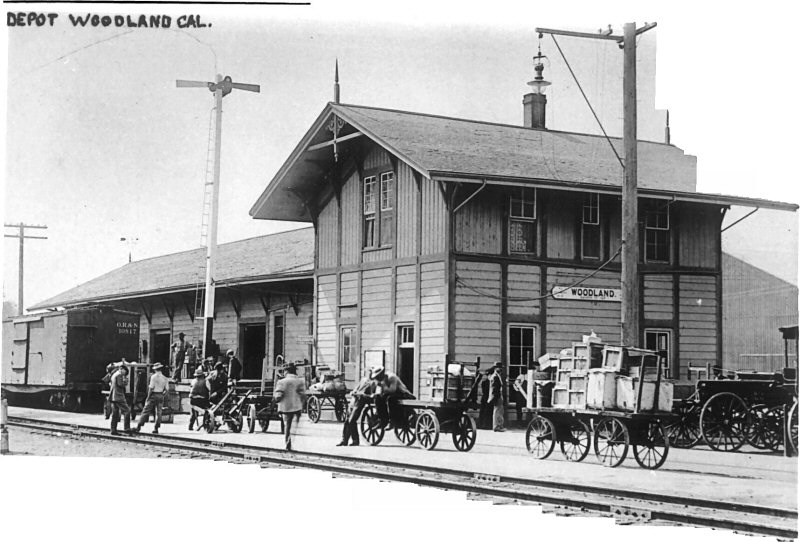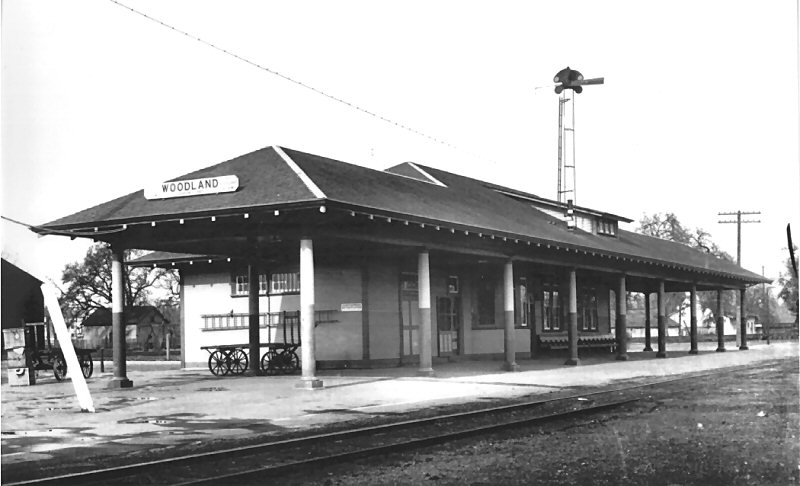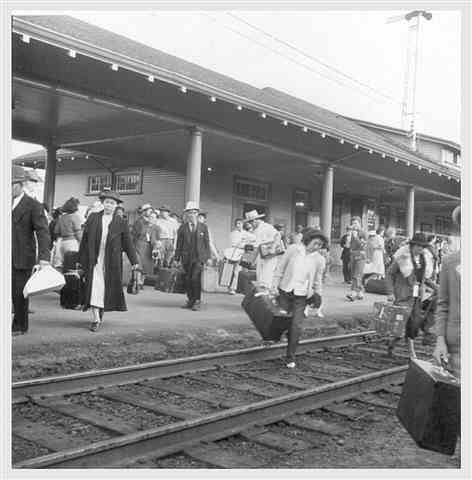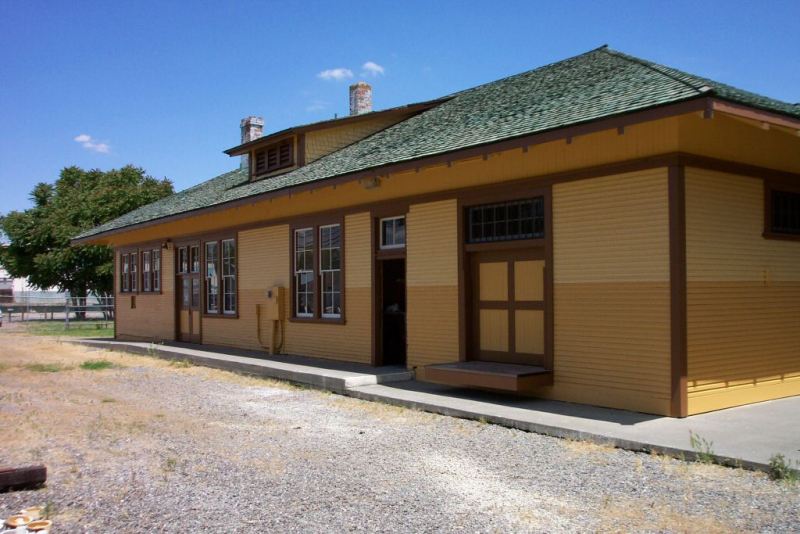|
A Short History of the Southern Pacific Woodland Depot
The California Pacific Railroad, a predecessor of the Southern Pacific Railroad, built the first railroad depot in Woodland located between Main Street and Oak Street. It was a two story, box shaped structure with “living apartments” on the second floor for the station agent. It had a large freight house, but a small waiting room for passengers.  Realizing that such a structure was unsuitable for the growing city of Woodland, the Chamber of Commerce, on February 2, 1910, sent three of its members to San Francisco to talk to Southern Pacific officials about a new depot. When they returned to Woodland on the midnight train, they were able to report that a new passenger depot would be built, but they had no firm date as to when that event would occur. Rumors on the status of the new depot persisted until February 10, 1911, when Division Superintendent Sheridan arrived in Woodland on a special train. He informed Station Agent Fingland that General Manager’s Order No. 2 had been issued authorizing the construction of the new depot. The recent news that the Northern Electric Railway was building a rail line into Woodland with a new depot at Second and Main Streets probably hastened this decision. After some controversy, the City of Woodland allowed the Southern Pacific Railroad to locate the new depot south of the old depot. The new location straddled Lincoln Avenue and forced the closure of Lincoln Avenue to East Street but allowed long trains to stop in front of the new depot without having to uncouple at Main and Oak Streets for roadway traffic. Construction of the new Woodland Depot began and it was completed in 1911. The original blueprints, dated February, 1910, were revised on February 13, 1911. An additional blueprint for the cement work in the waiting rooms and restrooms is dated April 21, 1911. A Sanborn Insurance map dated January, 1912, shows the completed depot and the relocation of the old depot to a spot south of Lincoln Avenue and east of Sixth Street. The old depot was then designated as a freight only facility.  Constructed mostly of prime redwood and Douglas fir, the new depot was equipped with “every modern accommodation” for its time. It was a standard Southern Pacific colonnade style design with Colonial Revival and Craftsman elements. The 156’ long arcade on the east side was constructed to protect the passengers from the weather and was 40’ longer than the old depot to accommodate longer trains. It had a baggage room, station agent’s office, restrooms, and separate waiting rooms for men and women. The women’s waiting room provided a private room for unaccompanied women travelers and a place where mothers could nurse their children. During the early years of its operation, this depot was heavily patronized and was a stop for many scheduled trains on the West Valley Line. Historic photos regularly show large crowds in front of the depot. The depot was also witness to several historic events. On May 20, 1942, 418 Yolo County citizens of Japanese ancestry were required to board a train to the Merced Assembly Center. The majority were then sent on to the Granada Relocation Center in Colorado for the remainder of World War II. Famed Depression era photographer Dorothea Lange captured this emotional moment in a series of black and white photographs, one of which is shown here. The photos also show many of the architectural elements of the depot at that time.  In the early 1950s, Southern Pacific passenger service to Woodland declined and was eventually suspended. In 1955, the Greyhound Bus Company leased the two waiting rooms. They installed a ticket counter on the south wall and it is believed that they removed the wall between the two waiting rooms and put double doors on the north and west walls at this time. A Greyhound Bus sign was put on the north end of the roof. There were additional changes; In 1956, the depot was painted “an attractive shade of seafoam green” replacing its original colonial yellow paint scheme which was no longer popular with local residents. The next year, freight operations were moved from the old freight depot to the baggage room of the passenger depot. A door was installed between the agent’s office and the baggage room and the trunk platform was removed from the west wall of the baggage room. The sliding door above the trunk platform was raised to accommodate a truck loading dock that was installed in the western two thirds of the baggage room and extended through the doorway. The screen partitions were also removed from the counter in the office. Later, a restroom for train crews was constructed in the southeast corner of the baggage room accessed through a new exterior door in the south wall. By this time, the only railroad employee remaining at the depot was the local freight agent. By the 1980’s, the depot had fallen into disrepair and had not had a passenger train stop there for many years. On April 24, 1982, the last regularly scheduled passenger train through Woodland, Amtrak’s Train 11--the Starlight, rolled past the depot without stopping. The worst news came in 1988, when Southern Pacific announced plans to raze the depot. Having just installed a new computer system, Southern Pacific decided to transfer the station agent to Sacramento, where he could accomplish all of the Woodland work by telephone and computer. With that announcement, a group of local preservationists and rail fans went before the Woodland City Council. The Council was encouraged to try and save the depot, but cautioned that no local taxpayers’ money could be expected. A "Woodland S.P. Depot Committee" was then formed which consisted of representatives of Sacramento Valley Historical Railways, the Yolo County Historical Society, the City of Woodland, and members of the general public. Sacramento Valley Historical Railways, a local group that was restoring Southern Pacific steam locomotive 1233 at the Yolo Fair Grounds, agreed to lead the preservation movement. The committee approached the Southern Pacific Company and secured an agreement to have the depot donated to the Sacramento Valley Historical Railways with the provision that it be moved away from the railroad's main line. The railroad also agreed to sell its property located about 200 feet southwest of the depot to Sacramento Valley Historical Railways so that the depot could be relocated there. The original depot, converted to a freight depot, had been moved to this location but was burned down by transients in the 1970s. The committee applied for a Community Development Block Grant and raised matching funds to purchase the property. In 1990, the grant was approved, and the property was purchased from Southern Pacific in 1991. At the same time, the owner of the property adjacent to the new depot site at Sixth Street and Lincoln Avenue donated it to Sacramento Valley Historical Railways. A grain storage building that stood on this property was subsequently dismantled. This provided additional space to display locomotive 1233 and other full sized railroad equipment owned by Sacramento Valley Historical Railways. After many numerous delays, the depot was moved during the summer of 1992 and set on its new foundation. The cost of the move was donated by a individual and many Woodland businesses made donations of material and labor for the foundation. A chain link fence was erected around the depot so that repair and restoration could begin. Since the depot was moved, volunteers from Sacramento Valley Historical Railways have spent hundreds of hours restoring it to what it looked like in the early 1920s. |